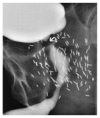Treatment of Urethral Strictures from Irradiation and Other Nonsurgical Forms of Pelvic Cancer Treatment
- PMID: 26494994
- PMCID: PMC4606407
- DOI: 10.1155/2015/476390
Treatment of Urethral Strictures from Irradiation and Other Nonsurgical Forms of Pelvic Cancer Treatment
Abstract
Radiation therapy (RT), external beam radiation therapy (EBRT), brachytherapy (BT), photon beam therapy (PBT), high intensity focused ultrasound (HIFU), and cryotherapy are noninvasive treatment options for pelvic malignancies and prostate cancer. Though effective in treating cancer, urethral stricture disease is an underrecognized and poorly reported sequela of these treatment modalities. Studies estimate the incidence of stricture from BT to be 1.8%, EBRT 1.7%, combined EBRT and BT 5.2%, and cryotherapy 2.5%. Radiation effects on the genitourinary system can manifest early or months to years after treatment with the onus being on the clinician to investigate and rule-out stricture disease as an underlying etiology for lower urinary tract symptoms. Obliterative endarteritis resulting in ischemia and fibrosis of the irradiated tissue complicates treatment strategies, which include urethral dilation, direct-vision internal urethrotomy (DVIU), urethral stents, and urethroplasty. Failure rates for dilation and DVIU are exceedingly high with several studies indicating that urethroplasty is the most definitive and durable treatment modality for patients with radiation-induced stricture disease. However, a detailed discussion should be offered regarding development or worsening of incontinence after treatment with urethroplasty. Further studies are required to assess the nature and treatment of cryotherapy and HIFU-induced strictures.
Figures
Similar articles
-
Management of bladder neck stenosis and urethral stricture and stenosis following treatment for prostate cancer.Transl Androl Urol. 2017 Jul;6(Suppl 2):S92-S102. doi: 10.21037/tau.2017.04.33. Transl Androl Urol. 2017. PMID: 28791228 Free PMC article. Review.
-
Is there a way to predict failure after direct vision internal urethrotomy for single and short bulbar urethral strictures?Arab J Urol. 2015 Dec;13(4):277-81. doi: 10.1016/j.aju.2015.07.007. Epub 2015 Sep 3. Arab J Urol. 2015. PMID: 26609447 Free PMC article.
-
Direct visual internal urethrotomy for isolated, post-urethroplasty strictures: a retrospective analysis.Ther Adv Urol. 2017 Feb;9(2):39-44. doi: 10.1177/1756287216679946. Epub 2016 Dec 2. Ther Adv Urol. 2017. PMID: 28203286 Free PMC article.
-
Presentation, management, and outcomes of complications following prostate cancer therapy.Transl Androl Urol. 2014 Jun;3(2):150-5. doi: 10.3978/j.issn.2223-4683.2014.04.05. Transl Androl Urol. 2014. PMID: 26816763 Free PMC article.
-
Urethral strictures and the cancer survivor.Curr Opin Urol. 2014 Jul;24(4):415-20. doi: 10.1097/MOU.0000000000000070. Curr Opin Urol. 2014. PMID: 24809412 Review.
Cited by
-
Voxel-level biological optimisation of prostate IMRT using patient-specific tumour location and clonogen density derived from mpMRI.Radiat Oncol. 2020 Jul 13;15(1):172. doi: 10.1186/s13014-020-01568-6. Radiat Oncol. 2020. PMID: 32660504 Free PMC article.
-
Endoscopic and non-endoscopic approaches for the management of radiation-induced rectal bleeding.World J Gastroenterol. 2016 Aug 21;22(31):6972-86. doi: 10.3748/wjg.v22.i31.6972. World J Gastroenterol. 2016. PMID: 27610010 Free PMC article. Review.
-
Management of bladder neck stenosis and urethral stricture and stenosis following treatment for prostate cancer.Transl Androl Urol. 2017 Jul;6(Suppl 2):S92-S102. doi: 10.21037/tau.2017.04.33. Transl Androl Urol. 2017. PMID: 28791228 Free PMC article. Review.
-
Disease- and Treatment-related Complication on F-18-Fluorodeoxyglucose Positron Emission Tomography/Computed Tomography in Oncology Practice: A Pictorial Review.Indian J Nucl Med. 2017 Oct-Dec;32(4):304-315. doi: 10.4103/ijnm.IJNM_78_17. Indian J Nucl Med. 2017. PMID: 29142347 Free PMC article.
-
Urological complications after radiation therapy-nothing ventured, nothing gained: a Narrative Review.Transl Cancer Res. 2021 Feb;10(2):1096-1118. doi: 10.21037/tcr-20-2589. Transl Cancer Res. 2021. PMID: 35116437 Free PMC article. Review.
References
-
- Latini J. M., McAninch J. W., Brandes S. B., Chung J. Y., Rosenstein D. SIU/ICUD consultation on urethral strictures: epidemiology, etiology, anatomy, and nomenclature of urethral stenoses, strictures, and pelvic fracture urethral disruption injuries. Urology. 2014;83(3, supplement):S1–S7. doi: 10.1016/j.urology.2013.09.009. - DOI - PubMed
-
- Zhao L. Contemporary Management of Anterior Urethral Strictures. AUA Update Series. lesson 18. Vol. 33. AUA; 2014.
-
- McDonald A. M., Baker C. B., Popple R. A., Cardan R. A., Fiveash J. B. Increased radiation dose heterogeneity within the prostate predisposes to urethral strictures in patients receiving moderately hypofractionated prostate radiation therapy. Practical Radiation Oncology. 2015;5(5):338–342. doi: 10.1016/j.prro.2015.02.010. - DOI - PubMed
Publication types
LinkOut - more resources
Full Text Sources
Other Literature Sources


